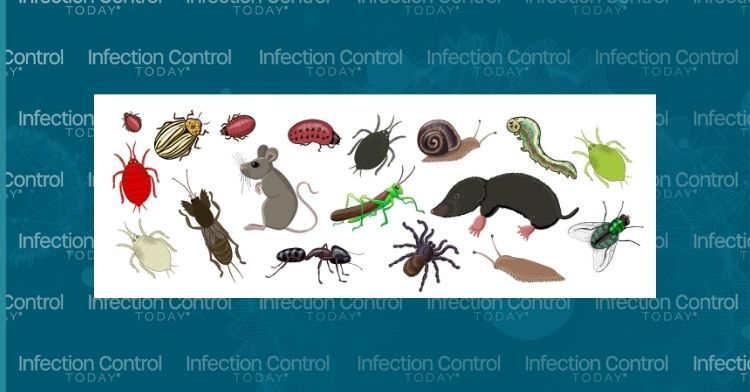Defending Health Care Facilities: Winter Pest Control and Sanitation Strategies
Cold weather can attract pests seeking warmth and shelter in health care facilities. Learn effective strategies, including sanitation and pest management, to protect patients this winter.
A set of animal pests of fields and gardens - mole, mouse, locust, fly, mole cricket, slug, Colorado potato beetle, aphid, ant. Drawing isolated on a white background.
(Adobe Stock 369346487 by Ольга Ева)

Effective pest control is critical to every industry—especially health care facilities, where pests can pose serious health risks to patients and damage a facility’s reputation. These issues can increase during periods of colder weather as pests use cracks and crevices to flee the outdoors, seeking food, water, and shelter inside.
From winter invaders (like rodents) to overwintering pests (such as stink bugs and ladybugs), these pests can cause a host of issues: the spread of diseases and pathogens, allergic reactions, product and food contamination, property damage, nuisance issues and general discomfort amongst patients and visitors.
Read on to learn more about the strategies you should take this winter to help prevent common seasonal pests in your facility and keep patients safe during the colder months.
Winter Pest Control Prevention Tips
Winter pests are best handled by an Integrated Pest Management (IPM) approach: an all-inclusive, ongoing, and proactive program focused on prevention for your facility. A successful IPM program:
- Is environmentally conscious and intentional in its measures.
- Involves the entire staff in the operation.
- Keeps detailed records of all pest activity and pest control operations.
A pest control provider should establish a comprehensive IPM program by:
- Thoroughly inspecting your facility to assess the pest situation.
- Implementing the most effective customized pest control measures to meet your facility's needs.
- Continuously monitoring the program’s effectiveness and performing check-ins as needed to ensure the facility is cared for.
Benjamin Hottel, PhD, BCE, PCQI
(Photo courtesy of Rollins)

Once your IPM program is in place, start with proactive exclusion tactics. Exclusion refers to techniques that include repairing, sealing off, and shutting down common pest entry points around your facility. This season’s pests are notoriously difficult to treat, often requiring conventional solutions and more specialized pest treatments. Keeping them out in the first place helps you avoid a long winter of battling pests, and an outright pest explosion come spring.
For the optimal partnership with your pest control provider, always provide documentation of pest sightings and spotting trends in your facility. Implementing a process for staff to report any signs of pest activity can help keep employees engaged and on the lookout. Always maintain open lines of communication with your pest control provider and communicate the importance of preventative measures internally.
Winter Sanitation & Maintenance
Proper sanitation practices are crucial to mitigating any potential pest issues in your facility all year round, but they are essential during the cold and flu season. As most pests are attracted to food debris, standing water, and clutter, eliminating these attractants as much as possible will help deter winter pests. There are several simple practices you can do to help keep your facility clean and safe:
- Secure Garbage Receptacles: Trash can be a huge attractant for pests, serving as a food source and prime real estate. Ensure that all your receptacles have tight-fitting lids and that outside dumpsters are placed far from your building.
- Implement a Regular Cleaning Routine: Regularly clean high-volume areas, like waiting rooms and lobbies, where new patients may unknowingly bring in pests. Clean up all food, water, and other liquid spills immediately, and encourage your staff to keep these areas tidy and free of debris. Floor drains should also be cleaned regularly.
- “Winterize” Your Facility: As water freezes, pipes can be increasingly strained in the winter. Before the months get even colder, check your facility’s insulation, and safeguard your pipes so leaks don’t attract pests.
- Properly Store Food: Keep all food sealed and stored properly in airtight containers, particularly in kitchens, cafeterias, and employee breakrooms. Educate patients and staff on best practices when handling food.
Navigating pest control in your health care facility requires intentional sanitation practices to keep patients and staff safe. You can help preserve your facility’s reputation and success by fostering an open communication environment and trust.
Help Safeguard Your Health Care Facility This Winter
As the colder months approach, pests seek refuge indoors, posing a significant threat to the hygienic environment crucial for patient wellbeing. Implementing rigorous pest control measures and maintaining impeccable sanitation practices during winter helps safeguard patients' health and safety and upholds the integrity of health care facilities through a dedication to cleanliness and infection control.
The CDC at a Crossroads: Budget Cuts, Public Health, and the Growing Threat of Infectious Diseases
March 12th 2025Budget cuts to the CDC threaten disease surveillance, outbreak response, and public health programs, increasing risks from measles, avian flu, and future pandemics while straining health care infrastructure nationwide.
Standing Up for Science: A Rally Participant’s Perspective
March 11th 2025Infection Control Today's Editorial Advisory Board member and contributing editor, Heather Stoltzfus, MPH, RN, CIC, recently joined the Stand Up for Science rally in Washington, DC. She gives a first-person perspective on the rally and the rally-goers' strong message.